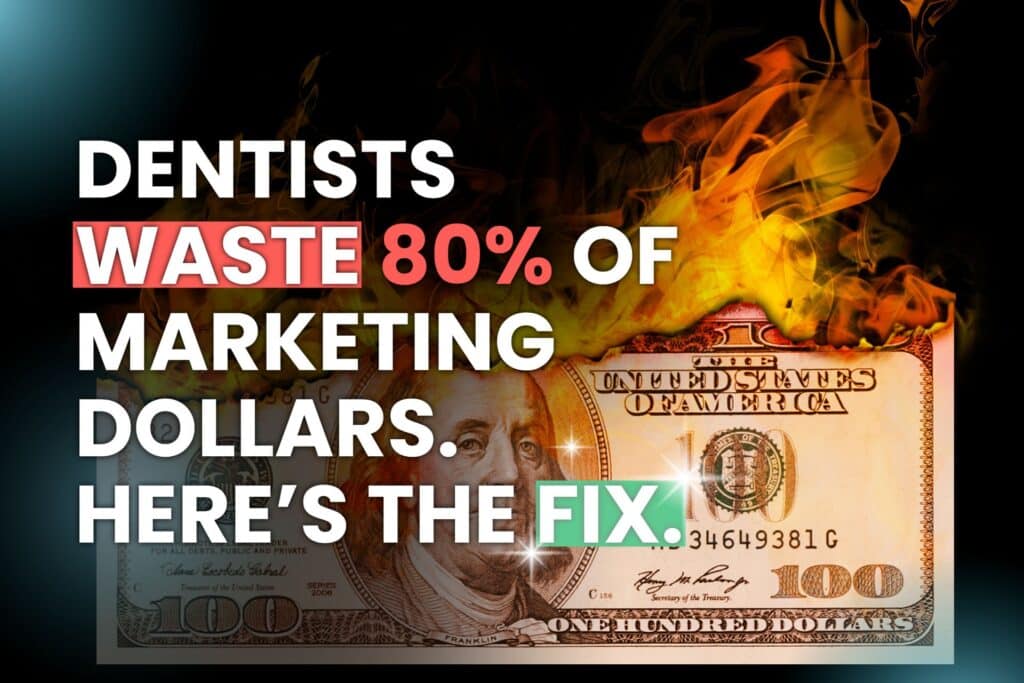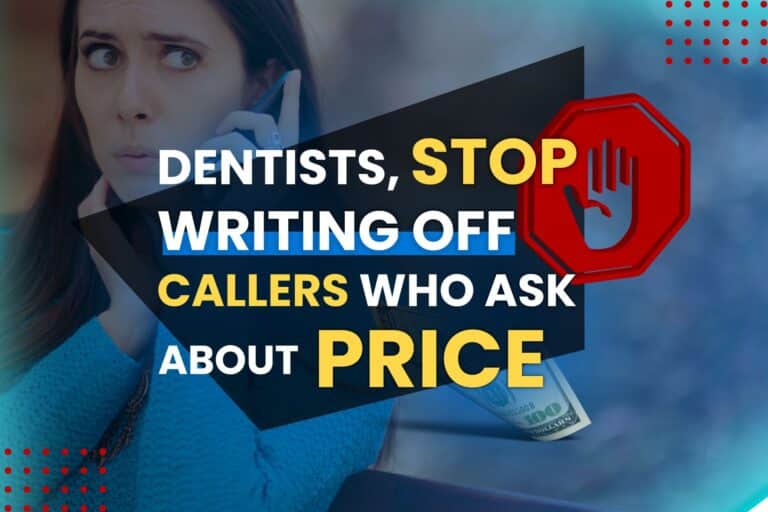Why is your dental practice wasting 80 percent of your marketing budget?
- Poor ad targeting
- Unclear NP avatar
- SEO problems
Okay, it’s a trick question. Why? Because the single biggest reason you’re losing marketing dollars is probably NOT bad marketing…
It’s how your team answers the phone. The average practice misses 35 percent of new patient phone calls entirely, and then converts only 30-50 percent of those calls they do answer. You might as well just take your marketing budget and set it on fire.
At least you could roast a marshmallow or two.
Phone conversion is the most crucial part of your new patient journey. If your team isn’t good at it, you can have the best marketing strategy in the world — and still fail to achieve the results you want.
That’s why we’ve spent thousands of hours coaching front desk teams across the country on how to turn 80 percent of calls from new patient leads into scheduled appointments. Keep reading to learn our three most essential tactics.
👉 Watch the video: Learn how to convert 80 percent of your phone calls into new patient appointments. Get the free course from SMC’s communication coach, Channan Cassella.
Remember, not all patients are alike
Before we get into specifics, we need to make it clear that not all new patient callers are the same. In fact, to improve your phone conversion, you first need to distinguish between two key types of callers: referral patients and marketing patients.
Referral patients are easy to work with. They’ve heard about your practice from a friend, loved one, or insurance provider, so they’re already inclined to trust you and will almost always move quickly to schedule an appointment. These types of patients are your dream patients.
Marketing patients are… trickier. Unlike referral patients, marketing patients have no real reason to trust you. They’re calling because they saw your ads or found you on Google. They may be shopping around. And if you don’t engage them properly on the phone, they will hang up and move on.
While referral patients schedule at close to a 100 percent rate, many practices convert only 30 percent of marketing patients into appointments. This can make marketing patients frustrating to deal with. But don’t give up on them, because they’re essential to your growth!
Ideally, your practice should get roughly 50 percent of all new patients from marketing. Despite any extra hassle, those patients will provide a consistent stream of revenue that is more predictable than referrals.
(Unless you distinguish between referral and marketing patients in your data, the easy wins from referral patients may trick you into thinking you’re better at phone conversion than you actually are. Given a roughly even split between referral and marketing patients, a 100 percent conversion rate for referrals and 30 percent for marketing will look like a decent 60 percent on paper — while hiding the fact that three out of every four patients created by your marketing don’t actually schedule with you.)
Identify marketing callers as soon as you pick up the phone
When you answer a phone call from a potential patient, one of the first things you want to do is determine whether you’re talking to a referral or a marketing patient. This is important for both tracking purposes and so you know how to handle the call.
Fortunately, there’s an easy way to do this. We’ve found that simply asking the question: “Who can we thank for referring you?” will help you learn whether a caller found you through a Google search or on the recommendation of a friend without feeling put upon.
Now, if a caller has found you through marketing, you need to focus on building trust ASAP. Here’s how to do that.
3 keys to converting 80% of your phone calls from marketing patients
We’ve already mentioned (more than once) that many practices convert only 30-50 percent of phone calls from marketing patients. That number can and should be much higher — we target 80 percent for our own clients.
Here are the 3 keys to hitting that 80 percent rate.
Excellent first impressions
In this case, the truism really is true. When you’re on the phone with a marketing patient, you’ve got to nail your first impression.
Remember, marketing patients don’t already trust you the way referral patients do. So you’ve got to win them over! This means building rapport by being:
- Friendly
- Welcoming
- Engaging
For example, let’s say a marketing patient calls to ask if you have any open appointments on the following day. You can either say:
“No, we don’t.”
Or you can say:
“No, but why don’t I take a look at our openings later in the week. What kind of help are you looking for?”
The first approach will almost certainly lead to the caller hanging up. But the second — actively making the effort to help the person on the phone while engaging them in additional conversation — will move you closer to a scheduled appointment.
(And if this example seems too on the nose… you’d be shocked by how many practices we’ve had to teach not to use option A.)
Redirecting bait questions
Early in a phone call with a marketing patient, they’ll probably ask you a make-or-break question that will determine whether they stay on the line or hang up. That type of question is called a bait question.
Examples of bait questions include:
- “Do you accept my insurance?”
- “How much do you charge for a crown?”
- “When is your next availability?”
Now, you don’t want to answer a bait question right away, because if you give an answer the caller doesn’t like, they’ll probably end the call. But you don’t want to refuse to answer the question, either, because the caller isn’t going to like that, either.
Try redirecting the bait question by saying something like:
“That’s a great question! Let me check into that for you. While I’m checking, who do I have the pleasure of speaking with?”
This way you can get the patient’s name, begin building rapport, and ask more questions to understand their motivations for seeking treatment so you can move the patient closer to scheduling. By the time you may have to give them an answer they don’t like, you’ve already built enough trust that you’ve got a good shot at scheduling anyway.
You can also use redirecting questions to educate the patient on what they don’t know. Say a patient immediately asks for pricing on a procedure like implants or crowns. You don’t want to quote a price because it may scare them off, but you don’t want to refuse them either.
So instead, you ask them questions that they won’t have answers to. Try something like:
“I’d love to give you a price on that. Do you know how many roots the tooth has? Do you know the bone density in the area? Do you know if the tooth is impacted?”
When the patient inevitably says “I don’t know,” you respond with:
“That’s totally normal. We do need this info for pricing, so let’s get you in on a free consultation so we can get answers to these questions.”
Using this approach will resolve the vast majority of bait questions. (And on the rare occasions when it doesn’t work, hey, you get a funny story for the break room later.)
Always lead to scheduling
While you want to be friendly and helpful on the phone, your primary goal for a marketing patient phone call is to get the patient scheduled. After all, the most helpful thing you can do is probably get that patient in front of your clinical team for an exam or consultation.
So don’t try to solve all a patient’s problems on a call. All your rapport-building should still be driving toward establishing when a caller wants to come in.
After you’ve been welcoming and friendly and answered or redirected any essential questions, you want to get down to business. But how you ask the big question matters.
If you simply say, “Do you want to schedule an appointment?” you’re giving the caller an easy opportunity to say no. Instead, try using what sales professionals call a dual-alternative close.
This just means asking something like:
“Would you prefer to schedule an appointment in the morning or the afternoon?” or
“Does 3 PM on Tuesday or 5 PM on Wednesday work better?”
What you’re doing is giving the patient two options that both achieve your goal — getting them scheduled — while allowing them to feel more in control of the situation.
That’s a win-win for you and the patient both.
Marketing + conversion = powerful NP growth
Want more growth than you could ever get from reading a blog post? We help entrepreneurial dentists increase revenue by boosting marketing, operations, and sales. Sign up for a free marketing plan to get started.






